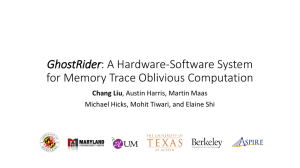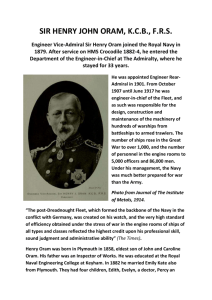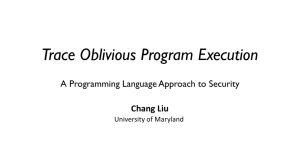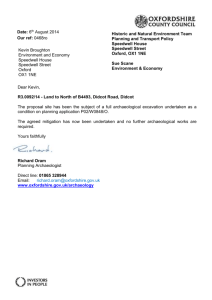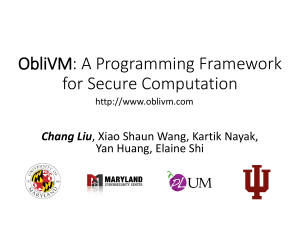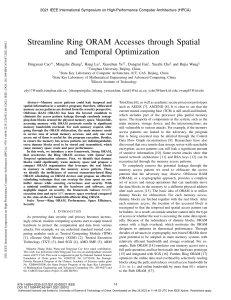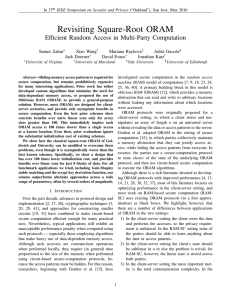Chang Liu The University of Maryland, College Park
advertisement
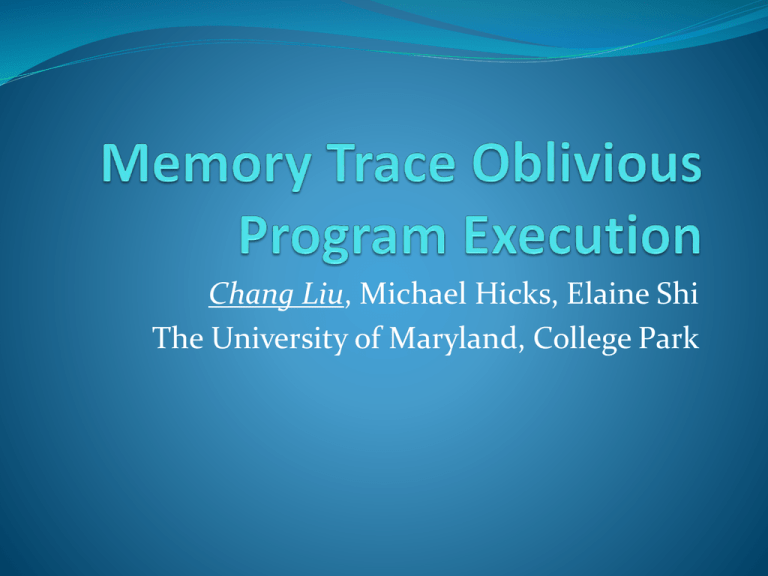
Chang Liu, Michael Hicks, Elaine Shi The University of Maryland, College Park Motivation Cloud computing compromise users’ privacy Transfer both code and data to the cloud provider Threat Model CPU and secure co-processor can be trusted All other hardware is not trusted Memory Memory bus Etc. Encryption is not enough Memory access trace may leak information about secret data Scenario 1 Program a[x]:=1 Memory bus read(x) readarr(a, x) Scenario 2 Program Memory bus if(s) then x:=1 else y:=1 read(s) true branch: write (x) false branch: write (y) Scenario 3 Program Memory bus 1: if(s) then 2: x:=1 3: else 4: x:=1 read(s) true branch: fetch instruction 2 false branch: fetch instruction 4 Oblivious RAM (ORAM) A primitive to hide access patterns from the untrusted server Practical implementation Ren et al. Design Space Exploration and Optimization of Path Oblivious RAM in Secure Processors, In Proc. of ISCA ‘13 Drawback 𝑂(log 3 𝑁) overhead for an ORAM of size 𝑁 Problem with ORAM Program 1 a[1]:=0 a[] can be store in DRAM w/o Program 2 for i=1→10 a[i]=1 a[] can be store in DRAM w/ Program 3 for i=1→10 a[] can be stored in DRAM w/ b[a[i]]=i c[a[i]]=c[a[i]]+1 end for encryption encryption encryption; b[] and c[] can be stored in two ORAM banks Observations Some data can be stored in DRAM w/ or w/o encryption Some data need be stored in ORAM We can use multiple ORAM banks to store different data Question ORAM Secure Inefficient Tradeoff (This work) Normal Program Secure Insecure Efficient Efficient Questions: How to do this safely? Q1: What programs are secure Memory trace non-interference Q2: How to check if a program is secure A security type system with trace Q3: How to get a secure program A security compiler Language Syntax Trace 𝐫𝐞𝐚𝐝 𝑥, 𝑛 𝐫𝐞𝐚𝐝𝐚𝐫𝐫 𝑥, 𝑛1 , 𝑛2 𝐰𝐫𝐢𝐭𝐞 𝑥, 𝑛 𝐰𝐫𝐢𝐭𝐞𝐚𝐫𝐫 𝑥, 𝑛1 , 𝑛2 𝐟𝐞𝐭𝐜𝐡 𝑝 𝑜 𝑡1 @𝑡2 Memory Memory 𝑀 is a mapping, which maps a variable to a pair (𝑣, 𝑙) 𝑣 is either a Nat or a mapping from Nat to Nat (i.e. array) 𝑙 is a security label which is either L or an ORAM A security environment Γ is a mapping from variable to a type (i.e. Nat l, or Array l) (Γ-validity) 𝑀 is Γ-valid Γ 𝑥 = 𝑁𝑎𝑡 𝑙 ⇔ ∃𝑛 ∈ 𝑁𝑎𝑡. 𝑀 𝑥 = 𝑛, 𝑙 Γ 𝑥 = 𝐴𝑟𝑟𝑎𝑦 𝑙 ⇔ ∃𝑛 ∈ 𝑁𝑎𝑡 → 𝑁𝑎𝑡. 𝑀 𝑥 = 𝑚, 𝑙 Semantics 𝑀 𝑥 = (𝑛, 𝑙) 𝑡 = 𝑒𝑣𝑡(𝑙, 𝐫𝐞𝐚𝐝(𝑥, 𝑛)) 𝑀, 𝑥 ⇓𝑡 𝑛 𝑀, 𝑒 ⇓𝑡 𝑛 𝑀 𝑥 = (𝑛′ , 𝑙) 𝑡 ′ = 𝑒𝑣𝑡(𝑙, 𝐰𝐫𝐢𝐭𝐞 𝑥, 𝑛 ) 𝑀, 𝑥 ≔ 𝑒 ⇓𝑡@𝑡′ 𝑀[𝑥 ↦ 𝑛, 𝑙 ] Memory Trace Non-interference DEF. Given a security environment Γ, a program 𝑆 satisfies Γ-memory trace obliviousness if for any two Γvalid memories 𝑀1 ∼𝐿 𝑀2 if 𝑀1 , 𝑆 ⇓𝑡1 𝑀1′ and 𝑀2 , 𝑆 ⇓𝑡2 𝑀2′ , then 𝑡1 ≡ 𝑡2 , and 𝑀1′ ∼𝐿 𝑀2′ Security Type System Cannot get trace without given memory configuration Trace Pattern 𝐑𝐞𝐚𝐝 𝑥 𝐑𝐞𝐚𝐝𝐚𝐫𝐫 𝑥 𝐖𝐫𝐢𝐭𝐞(𝑥) 𝐖𝐫𝐢𝐭𝐞𝐚𝐫𝐫(𝑥) 𝐋𝐨𝐨𝐩(𝑝, 𝑇, 𝑇) 𝐅𝐞𝐭𝐜𝐡(𝑝) 𝑂 𝑇@𝑇 𝑇+𝑇 Security Type System (cont’d) Γ ⊢ 𝑒: 𝑁𝑎𝑡 𝑙; 𝑇 Γ 𝑥 = 𝑁𝑎𝑡 𝑙′ 𝑙0 ⊔ 𝑙 ⊑ 𝑙 ′ Γ, 𝑙0 ⊢ 𝑥 ≔ 𝑒; 𝑇@𝑒𝑣𝑡 𝑙 ′ , 𝐖𝐫𝐢𝐭𝐞 𝑥 Γ ⊢ 𝑒: 𝑁𝑎𝑡 𝑙; 𝑇 Γ, 𝑙 ⊔ 𝑙0 ⊢ 𝑆𝑖 ; 𝑇𝑖 𝑖 = 1,2 𝑙 ⊔ 𝑙0 ≠ 𝐿 ⇒ 𝑇1 ∼𝐿 𝑇2 ∧ 𝑇 ′ = 𝑇1 𝑙 ⊔ 𝑙0 ≠ 𝐿 ⇒ 𝑇 ′ = 𝑇1 + 𝑇2 Γ, 𝑙0 ⊢ 𝐢𝐟 𝑒, 𝑆1 , 𝑆2 ; 𝑇@𝑇′ Soundness Theorem 1. If Γ, 𝑙 ⊢ 𝑆; 𝑇, then 𝑆 satisfies memory trace obliviousness Compilation 1. Type checking Standard 2. Allocating variables to ORAM banks Allocate each secret variable in a separate ORAM bank Other allocation strategy (open) 3. Insert padding instructions (for If) Least common subsequence problem Evaluation Programs Dijstra (100 nodes, 10,000 edges) K-means (100 data points, k=2) Matrix Multiplication (40 × 40, 20 × 20) Compilation Strategies Strawman: place all secret variables in a giant ORAM bank Opt 1: Store each variable in a separate ORAM bank, but store whole array in the same ORAM bank Opt 2: store each element in an array in a different ORAM bank when possible (equivalent to encryption only) Asymptotic Analysis Progra m Memory accesses for data Memory accesses for instructions Strawman Strawman Opt 1 Opt 2 𝑂(𝑛2 log 2 𝑛) 𝑂(𝑛2 𝑃 log 𝑐 𝑃) Dijstra 𝑂(𝑛2 log 2 𝑛) 𝑂(𝑛2 log 2 𝑛) K-means 𝑂(𝐼𝑛𝑘 log 𝑐 𝑛) 𝑂(𝐼𝑛𝑘 log 𝑐 𝑛) Mat. mul. 𝑂(𝑛3 log c 𝑛) Find max. 𝑂(𝑛 log c 𝑛) Opt 1 Opt 2 𝑂(𝑛2 𝑃) 𝑂(𝑛2 𝑃) 𝑂(𝐼𝑛𝑘) 𝑂(𝐼𝑛𝑘𝑃 log 𝑐 𝑃) 𝑂(𝐼𝑛𝑘𝑃) 𝑂(𝐼𝑛𝑘𝑃) 𝑂(𝑛3 log c 𝑛) 𝑂(𝑛3 ) 𝑂(𝑛3 𝑃 log c 𝑃) 𝑂(𝑛3 𝑃) 𝑂(𝑛3 𝑃) 𝑂(𝑛 log c 𝑛) 𝑂(𝑛) 𝑂(𝑛𝑃 log c 𝑃) 𝑂(𝑛𝑃) 𝑂(𝑛𝑃) Simulation Results Conclusion Q&A
